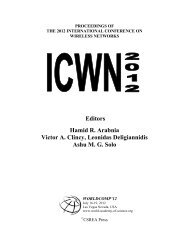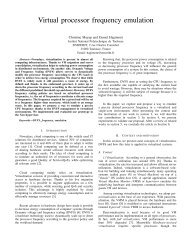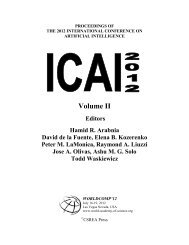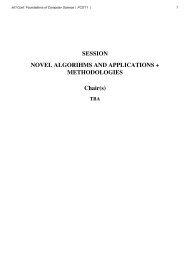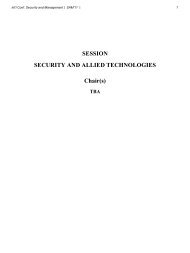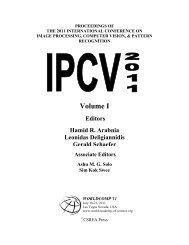SESSION GRAPH BASED AND TREE METHODS + RELATED ...
SESSION GRAPH BASED AND TREE METHODS + RELATED ...
SESSION GRAPH BASED AND TREE METHODS + RELATED ...
- TAGS
- graph
- methods
- world-comp.org
You also want an ePaper? Increase the reach of your titles
YUMPU automatically turns print PDFs into web optimized ePapers that Google loves.
8 Int'l Conf. Foundations of Computer Science | FCS'12 |<br />
Proof: Consider the VMTL with components labeled<br />
[1, 62, 20, 34, 29, 53], [2, 65, 16, 35, 32, 49],<br />
[3, 61, 19, 36, 28, 52], [4, 57, 22, 37, 24, 55],<br />
[5, 60, 18, 38, 27, 51], [6, 56, 10, 50, 12, 54],<br />
[7, 66, 17, 33, 40, 43], [8, 63, 23, 30, 41, 45],<br />
[9, 59, 15, 42, 26, 48], [11, 58, 14, 44, 25, 47],<br />
and [13, 64, 21, 31, 46, 39].<br />
This VMTL has a magic constant of 116. The first five<br />
components have common differences of 3s. Therefore, by<br />
using Lemma 2.3 five times, we have VMTLs of 119C3 with<br />
magic constants 113, 110, 107, 104 and 101. By duality, there<br />
exist VMTLs with magic constants of 85, 88, 91, 94, 97, and<br />
100.<br />
Next, consider the VMTL with components labeled<br />
[1, 59, 22, 34, 26, 55], [2, 60, 20, 35, 27, 53],<br />
[3, 66, 13, 36, 33, 46], [4, 63, 15, 37, 30, 48],<br />
[5, 56, 10, 49, 12, 54], [6, 58, 17, 40, 24, 51],<br />
[7, 65, 19, 31, 41, 43], [8, 57, 11, 47, 18, 50],<br />
[9, 64, 23, 28, 45, 42], [14, 62, 21, 32, 44, 39],<br />
and [16, 61, 29, 25, 52, 38].<br />
This VMTL has a magic constant of 115. The first four<br />
components have common differences of 3s. By using<br />
Lemma 2.3 four times, there exist VMTLs of 11C3 with<br />
magic constants of 112, 109, 106 and 103. By duality, there<br />
exist VMTLs with magic constants of 86, 89, 92, 95, and 98.<br />
Finally, in [27] it was shown that there exist VMTLs of<br />
11C3 with magic constants with values 117, 114, 111, 108,<br />
105, 102, 99, 96, 93, 90, 87 and 84.<br />
References<br />
[1] H.R. Andersen and H. Hulgaard, “Boolean Expression Diagrams,”<br />
Information and Computation, vol. 179, pp. 194-212, 2002.<br />
[2] M. Baca, M. Miller and J.A. MacDougall, “Vertex-magic total labelings<br />
of generalized Peterson graphs and convex polytopes,” J. Combin.<br />
Math. Combin. Comput., vol. 59, pp. 89-99, 2006.<br />
[3] M. Baca, M. Miller and Slamin, “Every generalized Peterson graph<br />
has a vertex-magic total labeling,” Int. J. Comp. Math., vol. 79, pp.<br />
1259-1263, 2002.<br />
[4] A. Baker and J. Sawada, “Magic Labelings on Cycles and Wheels,”<br />
in 2nd Annual International Conference on Combinatorial Optimization<br />
and Applications (COCOA ’08), Lecture Notes in Mathematics,<br />
vol. 5165, pp. 361-373, 2008.<br />
[5] O. Berkman, M. Parnas and Y. Roditty, “All cycles are edge-magic,”<br />
Ars Combin., vol. 59, pp. 145-151, 2001.<br />
[6] R.E. Bryant, “Symbolic Boolean Expression Manipulation with Ordered<br />
Binary Decision Diagrams,” ACM Computing Surveys, Vol. 24,<br />
No. 3, pp. 294-318, 1992.<br />
[7] S.A. Cook, “The complexity of theorem-proving procedures,” in<br />
Proceedings of the third annual ACM symposium on the Theory of<br />
computing, ACM, NY, 1971, pp. 151-158.<br />
[8] T.H. Cormen, C.E. Leiserson, R.L. Rivest, and C. Stein, Introduction<br />
to Algorithms, 3rd ed. MIT Press, 2009.<br />
[9] M. Davis, G. Logemann, and D. Loveland, “A Machine Program for<br />
Theorem Proving,” Communications of the ACM, vol. 3, pp. 394-397,<br />
1962.<br />
[10] G. Exoo, A.C.H. Ling, J.P. McSorley, N.C.K. Phillips, W.D. Wallis,<br />
“Totally magic graphs,” Discrete Math., vol. 254, pp. 103-113, 2002.<br />
[11] D. Froncek, P. Kovar and T. Kovarova, “Vertex magic total labeling<br />
of products of cycles,” Australas J. Combin., vol. 33, pp. 169-181,<br />
2005.<br />
[12] J.A. Gallian, “A dynamic survey of graph labeling,” Electronic J.<br />
Combin., vol. 17, #DS6, 2010.<br />
[13] R.D. Godbold and P.J. Slater, “All cycles are edge-magic,” Bull. Inst.<br />
Combin. Appl., vol. 22, pp. 93-97, 1998.<br />
[14] I. Gray, “New construction methods for vertex-magic total labelings<br />
of graphs,” Ph.D. thesis, University of Newcastle, 2006.<br />
[15] I. Gray, “Vertex-magic total labellings of regular graphs,” SIAM J.<br />
Discrete Math., vol. 21, Issue 1, pp. 170-177, 2007.<br />
[16] I.D. Gray and J.A. MacDougall, “Vertex-magic labelings of regular<br />
graphs II.,” Discrete Math., vol. 309, pp. 5986-5999, 2009.<br />
[17] E.A. Hirsch, and A. Kojevnikov, “UnitWalk: A new SAT solver<br />
that uses local search guided by unit clause elimination,” Annals of<br />
Mathematics and Artificial Intelligence, vol. 43, pp. 91-111, 2005.<br />
[18] J. Holden, D. McQuillan, and J.M. McQuillan, “A conjecture on strong<br />
magic labelings of 2-regular graphs,” Discrete Mathematics, vol. 309,<br />
pp. 4130-4136, 2009.<br />
[19] The International Conferences on Theory and Applications of Satisfiability<br />
Testing (SAT). [Online]. Available: http://www.satisfiability.org<br />
[20] G. Jäger, “An effective SAT encoding for magic labeling,” in Proceedings<br />
of the 9th Cologne Twente Workshop on Graphs and Combinatorial<br />
Optimization (CTW 2010), 2010, pp. 97-100.<br />
[21] A. Kotzig and A. Rosa, “Magic valuations of finite graphs,” Canad.<br />
Math. Bull., vol. 13, pp. 451-461, 1970.<br />
[22] P. Kovar, “Vertex magic total labeling of products of regular VMT<br />
graphs and regular supermagic graphs,” J. Combin. Math. Combin.<br />
Comput., vol. 54, pp. 21-31, 2005.<br />
[23] Y. Lin and M. Miller, “Vertex-magic total labelings of complete<br />
graphs,” Bull. Inst. Combin. Appl., vol. 33, pp. 68-76, 2001.<br />
[24] J.A. MacDougall, M. Miller, Slamin, and W.D. Wallis, “Vertex-magic<br />
total labelings of graphs,” Utilitas Mathematica, vol. 61, pp. 3-21,<br />
2002.<br />
[25] D. McQuillan, “Edge-magic and vertex-magic total labelings of certain<br />
cycles,” Ars Combin., vol. 91, pp. 257-266, 2009.<br />
[26] D. McQuillan, “A technique for constructing magic labelings of<br />
2−regular graphs,” JCMCC, vol. 75, pp. 129-135, 2010.<br />
[27] D. McQuillan and J.M. McQuillan, “Magic Labelings of Triangles,”<br />
Discrete Mathematics, vol. 309, pp. 2755-2762, 2009.<br />
[28] D. McQuillan and K. Smith, “Vertex-magic total labeling of multiple<br />
complete graphs,” Congr. Numer., vol. 180, pp. 201-205, 2006.<br />
[29] D. McQuillan and K. Smith, “Vertex-magic total labeling of odd<br />
complete graphs,” Discrete Math., vol. 305, pp. 240-249, 2005.<br />
[30] J.P. McSorley and W.D. Wallis, “On the spectra of totally magic<br />
labelings,” Bull. Inst. Combin. Appl., vol. 37, pp. 58-62, 2003.<br />
[31] Y. Roditty and T. Bachar, “A note on edge-magic cycles,” Bull. Inst.<br />
Combin. Appl. vol. 29, pp. 94-96, 2000.<br />
[32] B. Selman, H. Kautz, and B. Cohen, “Local Search Strategies for<br />
Satisfiability Testing,” in Cliques, Coloring, and Satisfiability: Second<br />
DIMACS Implementation Challenge, October 11-13, 1993.<br />
[33] W.D. Wallis, “Vertex magic labelings of multiple graphs,” Congr.<br />
Numer., vol. 152, pp. 81-83, 2001.<br />
[34] W.D. Wallis, Magic Graphs. Boston, MA: Birkhauser, 2001.<br />
[35] W.D. Wallis, “Two results of Kotzig on magic labelings,” Bull. Inst.<br />
Combin. Appl., vol. 36, pp. 23-28, 2002.



